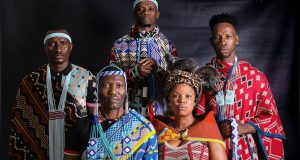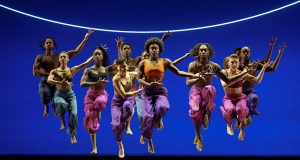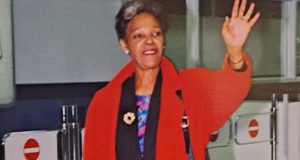By Neil Armstrong
Pride Contributing Writer
A Review
TORONTO, Ontario – The National Dance Theatre Company (NDTC) of Jamaica returned to Toronto after 15 years with a delightful showcase of its repertoire – some old, some new to us in Canada – but all steeped in the excellence of the premier dance company.
Artistic director, Barry Moncrieffe, notes that the connection with Canada dates back to the year after the NDTC’s inception in 1962 when the company had appearances at the Shakespearean Festival in Stratford, Ontario.
The next visit to Canada was to Montreal at Expo ’67 and in the 70s, the NDTC performed at the O’Keefe Centre (now the Sony Centre for the Performing Arts) where the company performed on November 4.
The company also performed at the National Arts Centre in Ottawa and at the Ryerson Theatre and the Theatre in New College in Toronto in the ‘80s. There were also performances in Edmonton before the company returned and performed in Toronto and Ottawa in 1999, fifteen years ago.
“We see Canada, then, as providing some life-blood to the growth and development of the NDTC in our ceaseless quest for excellence and cultural certitude through exploration and experimentation,” says Moncrieffe in the programme.
Under the theme of “renewal and continuity,” the NDTC showcased three of its seasoned and seminal works – “Dialogue For Three” (1963), “Sulkari” (1980) and “Gerrehbenta” (1983) – and three choreographed post-1999, — “Urban Fissure” (2004), “Dimensions (excerpt)” (2004) and “…minutes and seconds” (2010). The NDTC Singers and Orchestra also provided a romp down memory lane with “Play Time,” expressions of “the reality of the various dimensions of playtime with its triumps, disappointments, joys and pain.”
Opening with “Urban Fissure,” choreographed by Chris Walker to the music of Bob Marley’s “No More Trouble” featuring Eryka Badu and Marley’s “Rastaman Chant” featuring Busta Rhymes Dexter Pottinger, the five dancers evoked the dexterity of movement needed and the lived experiences in urban centres.
After the NDTC Singers and Orchestra performed a medley of songs that reminded many of their childhood with songs like “Go Down a Manuel Road” and “Evening Time,” there was “…minutes and seconds.”
Choreographed by Kerry-Ann Henry and Momo Sanno, and performed by Marlon Simms and Kerry-Ann Henry, it is an interpretation of Joyce Meyer’s quotation, “Life is sometimes very complicated…Lets purposely learn to enjoy the simple yet powerful things God has created!”
Henry and Simms demonstrate this through modern and classical ballet – in essence they are being playful and enjoying life.
The seminal work, “Súlkari,” is “a dance of exaltation in fecundity and fertility, so that through the man-woman relationship the life of man will continue.”
Choreographed by Eduardo Rivero-Walker, it featured Marlon Simms, Keita-Marie Chamberlain, Jillian Samms, Tamara Noel, Kevin Moore, Allatunje Connell and Mark Phinn.
“The forms of the dance were inspired by, and originate from the sculpture, carvings, headdresses, masks, stools and other elements and details of African sculpture, as well as the movement of the Yoruba peoples of Arara (Dahomey),” notes a description of the work.
The elaborate dance starts includes three female dancers who are soon joined by three male dancers, carrying sticks, who elevate the women on their shoulders, to traditional Afro-Cuban (Yoruba) music collected and arranged by Rivero-Walker.
The strength and endurance of the dancers are evidenced in their ceremonial dance, as if in honour of the Yoruba goddess, Oshun (who reigns over love, intimacy, beauty).
The much-lauded Nettleford masterpiece, “Dialogue For Three” (1963), a true feminist libretto and a tense tale of three, is a classic tutorial in male struggle and helplessness “in the face of female force.”
With music by Joaquin Rodrigo, Marisa Benain as the wife; Maia Pereira as the other woman; and Kevin Moore as the man are caught up in what is described as the “eternal struggle” and it is “the woman who decides.”
Indeed, the dialogue continued beyond the Sony Centre’s stage with private discussions of many in the audience about how things turned out in the love triangle.
An excerpt of “Dimensions” choreographed by Arsenio Andrade-Calderon with dancers, Kerry-Ann Henry and Mark Phinn, showcased their dexterity and the precision required in the dance movements.
Henry and Phinn demonstrate this through their vibrant and acrobatic movements, contortion of body – they present a prism of what’s possible for the human body with much training.
The performance ended with “Gerrehbenta,” the dance takes its name from two of the major traditional rites practised in Jamaica – “gerreh” in Hanover and “dinky-mini” which uses the musical instrument, the benta, in St. Mary.
Choreographed by the late co-founder with traditional music arranged by Marjorie Whylie, with NDTC Singers, musicians and drummers, and involving the whole company, as dancers, it was this piece that most poignantly reminded patrons of Nettleford.
Tapping into the folklore of Jamaica, this piece was well chosen to end the event which was entitled Tribute to Rex, in honour of the late Rex Nettleford, co-founder of the NDTC, a public intellectual, an activist and a global citizen who died in 2010. The company was founded with Eddy Thomas in 1962 to mark Jamaica’s independence.
“Gerreh” and “dinky-mini” are dances of African origin of the wake tradition usually performed after the death of a person, and up until the ninth night after the death. These sessions are usually held to cheer the bereaved.
“Dinkies are celebratory occasions. Although associated with death, the music is lively, joyous and exciting, intending to cheer the family and friends of the dead person… The Dinki Mini dance focuses on the pelvic region as it is performed in defiance of the death that has occurred,” notes the online source, Chat-bou.net.
Seth George Ramocan, Jamaica’s consul general at Toronto and honorary chair of Group Arts Jam, the planning committee of the event said the idea to bring the NDTC to Toronto was his wife, Dr. Lola Ramocan’s idea.
He thanked her, Camille Hines, committee chair; Jerrold Johnson, chief representative officer of Jamaica National; Denise Jones of Jones & Jones Productions Ltd., and all those involved in making the event a reality.
Ramocan, whose tenure ends this month, said he was glad that he was able to bring the NDTC to Toronto while in office. Johnson said Jamaica National was committed to make it happen.
 Pride News Canada's Leader In African Canadian & Caribbean News, Views & Lifestyle
Pride News Canada's Leader In African Canadian & Caribbean News, Views & Lifestyle





